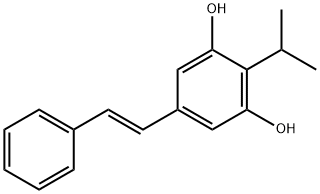- Benvitimod
-

- $40.00 / 1mg
-
2024-08-27
- CAS:79338-84-4
- Min. Order: 50mg
- Purity: 99.5%
- Supply Ability: 50
- Benvitimod
-

- $0.00 / 1KG
-
2024-07-06
- CAS:79338-84-4
- Min. Order: 1KG
- Purity: 99.5%
- Supply Ability: 500kg
|
| Product Name: | Tapinarof | | Synonyms: | 3,5-Dihydroxy-4-isopropylstilbene;(E)-2-(1-Methylethyl)-5-(2-phenylethenyl)-1,3-benzenediol;2-(1-methylethyl)-5-[(E)-2-phenylethenyl]benzene-1,3-diol;3,5-Dihydroxy-4-isopropyl-trans-stilbene;GSK2894512);Tapinarof (WBI 1001;WB-1001;WBI-1001 | | CAS: | 79338-84-4 | | MF: | C17H18O2 | | MW: | 254.32 | | EINECS: | 1312995-182-4 | | Product Categories: | | | Mol File: | 79338-84-4.mol |  |
| | Tapinarof Chemical Properties |
| Melting point | 140 - 142°C | | Boiling point | 431.8±20.0 °C(Predicted) | | density | 1.158 | | storage temp. | 2-8°C | | solubility | Chloroform (Slightly), Methanol (Slightly) | | pka | 9.86±0.15(Predicted) | | form | Solid | | color | Pale Brown to Light Brown |
| | Tapinarof Usage And Synthesis |
| Description | Tapinarof is a small molecule stilbene compound, with a chemical name of 3,5-Dihydroxy-4-isopropylstilbene,which was originally isolated from the metabolite of photorhabdus iuminescence, a soil nematode (Heterorhabditis sp.), and has been synthesized artificially. | | Biological activity | Tapinarof(GSK2894512) is a natural agonist of aryl hydrocarbon receptor (AhR) that induces nuclear translocation of AhR in immortalized keratinocytes (HaCaT) with EC50 of 0.16 nM. Benvitimod induces apoptosis in CD4+ T cells in a dose-dependent manner with an IC50 value of 5.2 μM. | | Uses | Clinically, tapinarof was first used in the treatment of psoriasis and atopic dermatitis. Clinical trials conducted abroad have shown that Benzenemod cream has good efficacy and safety on atopic dermatitis and psoriasis. In China, as a class 1.1 new drug, Benzenemod cream has undergone phase I-II clinical trials, and the results show that it has good efficacy and safety for plaque psoriasis. | | Clinical Use | Tapinarof is a novel small molecule topical therapeutic AhR ( aryl hydrocarbon receptor)-modulating agent that has been recently approved by the FDA for the topical treatment of plaque psoriasis in adults. Tapinarof 1% cream has shown to be effective and to have a favorable safety profile in the treatment of psoriatic patients[1]. It could decrease the expression of multiple essential cytokines involved in the pathological IL-23/IL-17/IL-22 axis and ameliorate IMQ-induced psoriatic dermatitis, inhibiting keratinocyte proliferation and abnormal differentiation. But tapinarof may have different effects on varied types of psoriasis[2]. Tapinarof can also specifically bind to and activate AHR leading to downregulation of TNF-α/IL-23/IL-17 and inhibition of IL-4/IL-13 mediated STAT6 activation, to achieve the purpose of treating nonulcerated necrobiosis lipoidica[3]. | | in vivo | Tapinarof acts through AhR to reduce inflammation in IMQ-treated mice. AhR-sufficient mice on a C57Bl/6 background exhibit a reduced clinical score after treatment with Tapinarof or 6-formylindolo(3,2-b)carbazole (FICZ). In contrast, AhR KO mice do not respond to the anti-inflammatory effects of Tapinarof. FICZ is used as a comparator in these studies and yields similar results, with dramatically reduced inflammatory responses in wild-type, but not AhR KO mice. | | References | [1] Bissonnette R, et al. Tapinarof for psoriasis and atopic dermatitis: 15?years of clinical research. Journal of the European Academy of Dermatology and Venereology, 2023; 37: 1168-1174.
[2] Zhu X, et al. The opposite effect of tapinarof between IMQ and IL-23 induced psoriasis mouse models. Experimental Dermatology, 2023.
[3] Palomares S, et al. Nonulcerated Necrobiosis Lipoidica Successfully Treated with Tapinarof: A Case Report. Clinical, Cosmetic and Investigational Dermatology, 2023; 16: 1373-1376. |
| | Tapinarof Preparation Products And Raw materials |
|